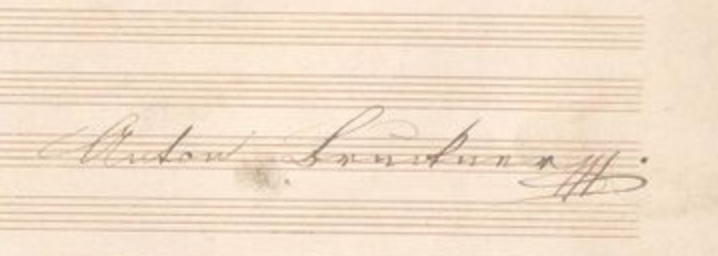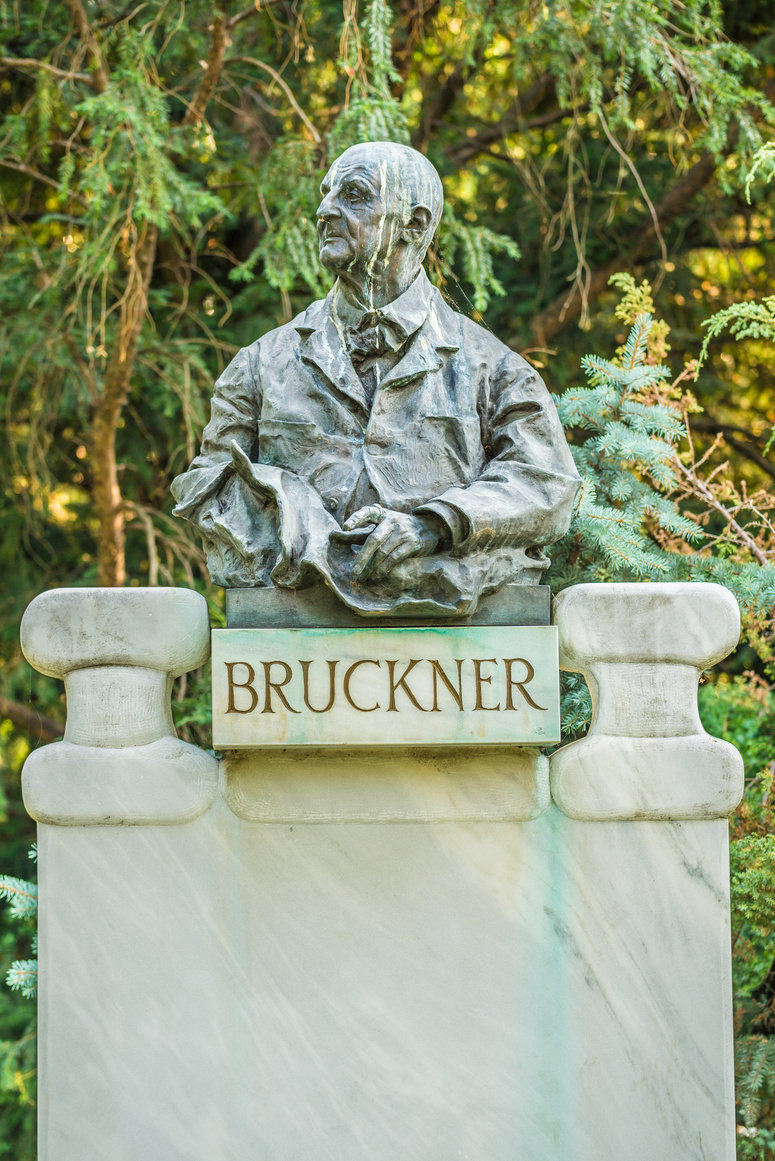September 2024, Issue 1
Choral repertoire vault
The Old and New in Choral Music Repertoire
200 years of bruckner

Anton Bruckner, born 200 years ago this month, composed over 100 choral works in his lifetime.
Click here to listen.
Five choral works by Bruckner:
Ave Maria - Hymn WAB 6
Christus factus est - WAB 11
Locus Iste - WAB 23
Os justi - WAB 30
Pange lingua - WAB 33
the Choral music of
anton bruckner
Written by Honey Meconi

Bruckner’s smaller-scale choral works are less well-known than those with orchestral accompaniment, though again many spectacular pieces fall into this category. Some of my favorites include the aforementioned Ave Maria; Locus iste (1869); Tota pulchra es (1878, with tenor and organ); Ecce sacerdos magnus (1885, with three trombones and organ); and Virga Jesse floruit (also 1885).
Many of Bruckner’s motets are unaccompanied, and in that respect fit into the Cecilian movement that was current in Austria and Germany while Bruckner was alive. This was a movement that strove to restore Catholic church music to the style of the distant past, as in plainchant and Palestrina. The emphasis was on functional church music of relatively simple compositional means. Although Bruckner was a devout Catholic, his taste in church music had been formed and influenced by the dramatic sacred music of Haydn, Mozart, Beethoven, Schubert, and
Mendelssohn, which often used full orchestral forces to
increase theatricality and affect.
Christus factus est
Christus factus est is his third and last setting of this text; the first time was in a youthful plenary mass (1844); the second setting, from 1873, includes instruments. Our version (1884, dedicated to Oddo Loidol, a priest in the Benedictine monastery of Kremsmünster) is SATB, departing from four voices only when the alto line splits in mm. 24, 27, 28, and 55, and the bass moves to octaves on the final note. Bruckner’s textural restraint is for naught, though, as he uses dynamics, rests, melodic contour, and especially harmony to create a blazing musical drama in a mere 79 measures. Consider for example the work’s constantly shifting dynamics, such as the move from a forte dynamic to pp in less than two measures (mm. 15–17; remember that the choral conductor Bruckner was a stickler for dynamics); the impact of general pauses in both mm. 20 and 56 (the first in the structurally appropriate position immediately before the verse); the move away from the home key of D Minor beginning already in m. 3, with the first firm cadence on the far distant key of D-flat Major in m. 19; a lively melodic contour that includes for example an upward leap of a tenth in m. 53 of the alto part; and the constantly shifting chromatic lines throughout: all appropriate for a text that reminds us of Christ’s ultimate sacrifice. The ever-changing key center makes the work challenging to keep in tune. Mad-Eye Moody’s exhortation for “constant vigilance!” is useful here, as is strict attention to uniform pronunciation of vowels.
Translation:
Christus factus est pro nobis,
Obediens usque ad mortem,
Mortem autem crucis.
Propter quod et Deus exaltavit illum,
Et dedit illi nomen
Quod est super omne nomen.
Christ was made for us,
Obedient even to death,
Death on the cross.
And God exalted him for that,
And gave him a name
That is above every name.
Os justi
Os justi (1879) is different from Christus factus
est in almost every respect beyond the lack of instruments. The choral forces are SSAATTBB; the dynamics shift and change rather more slowly than
in Christus factus est; general pauses are not indicated in the score (though all voices are silent before
the beginning of the verse at “Lex Dei eius”); the melodic motion is somewhat smoother. But the greatest contrast is harmonic, for Os justi is written in pure Lydian throughout.
Lydian was one of the medieval church modes, and its use in a late nineteenth-century motet is an obvious gesture to the past that would be appreciated by followers of the Cecilian movement. To simplify a complex matter, we can describe the medieval modes as the scale patterns from which music before 1600 was constructed (as opposed to the major and minor scales used to create later music). The scale patterns were specific mixtures of half and whole steps most readily described as the white notes on a piano from D to an octave above (Dorian); the white note octave on E (Phrygian); on F (Lydian); and on G (Mixolydian). Thus, a work in pure Lydian uses no B-flat despite its “tonic” of F. And, indeed, Os justi has no accidentals anywhere. It further eschews six-four chords and seventh chords, as Bruckner himself pointed out in a letter to its dedicatee. Yet despite these restrictions Bruckner manages to include harmonically effective devices such as a quick taste of the circle of fifths starting in m. 29, as well as yummy suspensions from m. 57 on. But the unison chanted “Alleluia” conclusion leaves no doubt as to where the heart of this composition lies, while the central fugal passage on “et lingua eius,” the longest such passage in his motets, is another gesture to Cecilian ideals (notwithstanding the initial G, D, A, and E entry pitches of the four parts).
Os justi was dedicated to Cecilianist Ignaz Traumihler, the chorus director of St. Florian, and it obviously suits the objectives of the Cecilian movement far better than does the thrilling Christus factus est. It also meets the Cecilian desire for a functional liturgical work. The text is that of the Gradual for the mass for the common of doctors (doctors of the church, that is, such as St. Augustine, St. Jerome, and—yes!—St. Hildegard of Bingen), and the premiere was at St. Florian on the litugically appropriate date of 28 August 1879—the Feast of Saint Augustine (a farewell gift; Traumihler died less than two months after the premiere). In contrast—as we might expect from the music’s style—the premiere of Christus factus est on 11 September 1884 was far removed from the text’s liturgical position as the Gradual for the evening mass on Holy Thursday. The text for Os justi is biblical, incidentally, Verses 30–31 of Psalm 36/37 (did you know that Catholics and Protestants number the Psalms differently? They do. Thank you, Martin Luther).
Translation:
Os justi meditabitur sapientiam
Et lingua eius loquetur judicium.
Lex Dei eius in corde ipsius
Et non supplantabuntur gressus eius.
Alleluia.
The mouth of the righteous utters wisdom
And his tongue speaks what is just.
The law of God is in his heart
And his feet do not falter.
Alleluia.
Click here to read more by Honey Meconi

New choral
publications
New publications become available every day. Here are some pieces published in 2023 and 2024 to investigate.
Ave Maria - Andrew Balfour (SSA a cappella)
Without Knowing - Henrik Dahlgren (SATB a cappella)
Before the West - Henrik Dahlrgren (SSATBB a cappella)
Caritas - Elaine Hagenberg (SATB, piano, violin)
Music of the Stars - Cecilia McDowall (3-movements)
The Light of Paradise - Paul Mealor (SATB; sax quartet)
Sunflower - Jacob Nerverud (SATB and cello)
Na gori je moj dom - Jan Triler (SATB div. a cappella)
O Sleeper, Awake! - Patrick Vu (SATB and piano)
On the Hill-Side - Patrick Vu (SATB and piano)
Commissions and consortiums
Written by Lorissa Mason
Commissioning a choral piece can be a rewarding and meaningful experience for you and for your ensemble, and it is more accessible than you may realize. Here are some things to consider as you begin the process.
1. Plan agead. Start the commissioning process well in advance of your desired performance.
2. Define your purpose. Is there a special event that warrants commissioning a piece? A specific text or theme?
3. Determine your budget. If you are not able to afford a commission with your ensemble, look into joining a consortium for a piece that fits your needs.
4, Create an agreement with the composer you wish to commission. Many composers already have their own contracts and procedures. Have these conversations.
5. Communicate with the composer. There are many decisions to be made along the way, and communication is the key to a successful and joyful experience. Remember - it is important to communicate your needs, and it is equally important to trust the composer’s expertise and creative process.
6. Enjoy the journey!

